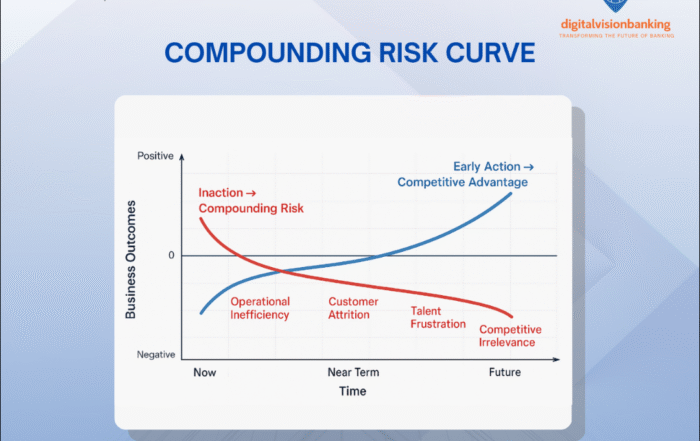
This infographic highlights how digital transformation in banking is not just about technology—it’s an operating model shift across people, process, technology, and strategy.
TL;DR – The Cost of Getting It Wrong: Why Inaction Compounds Into Competitive Disadvantage
-
Waiting feels safe—but it isn’t – Every quarter of delay quietly erodes competitiveness and amplifies hidden costs.
-
Inaction drains value – Customer attrition, inefficiency, deposit flight, and talent loss all rise while growth stalls.
-
Risks multiply over time – Small gaps in readiness turn into systemic disadvantages that are hard to reverse.
-
The market is moving fast – AI, fintech ecosystems, and cloud-native cores are redefining the playing field right now.
-
Why it matters – The earlier you act, the more transformation compounds in your favor—and the less it costs to catch up.
Community banks don’t fail because they try and miss. They fail because they wait too long to act. On the surface, a delay might feel safe. Leadership thinks, “Let’s wait until the budget looks better. Let’s hold off until the next vendor cycle.” But every quarter spent in limbo comes with hidden costs that compound over time. Lost opportunity costs are a real thing!
The Immediate Costs
Customer attrition. Younger generations want seamless onboarding, instant service, and personalized experiences. If you don’t offer it, someone else will.
Operational inefficiency. Manual processes that should be automated drain resources and slow growth.
Deposit flight. When convenience and value don’t line up, customers chase better rates and easier platforms.
Talent frustration. Your best employees won’t tolerate outdated systems and endless workarounds. They’ll leave for organizations where they can actually make an impact.
These aren’t abstract risks. They show up in every customer survey, every performance review, and every competitive win-loss report.
How Risks Compound
The danger isn’t just each of these costs on its own. The real damage comes from how they pile on top of each other:
- Losing deposits forces higher acquisition costs.
- Inefficiency creates resource strain that kills new initiatives.
- Attrition erodes morale, which accelerates talent loss.
What starts as a small delay spirals into a systemic disadvantage, which in some cases is hard to reverse.
The Bigger Risk: Falling Behind the Convergence
And then there’s the wave that’s already forming. Over the next three to five years, AI, fintech partnerships, cloud-native cores, automation, and even blockchain will converge into a new banking model.
Banks that keep mistaking surface fixes for transformation won’t just fall behind. They’ll wake up to find the gap has become unbridgeable.
What Leading Banks Are Doing Now
The institutions that avoid this trap aren’t waiting for perfect timing. They’re:
Taking a readiness-first approach using tools like the CSP Transformation Scorecard.
Redesigning processes today so new technology has a foundation to land on.
Building vendor ecosystems with long-term fit instead of one-off quick wins.
Preparing their teams for the future of work, where AI takes the routine and humans focus on relationships.
They know transformation isn’t a single event. It’s a compounding process in its own right—and the earlier you start, the more it pays off.
Final Word
The cost of getting digital wrong isn’t just wasted budget. It’s wasted time. Every quarter you delay makes the hill steeper.
Transformation is hard. But the longer you wait, the more expensive it gets.
The question isn’t whether you can afford to act. It’s whether you can afford not to.
But, you don’t have to go it alone. Engage with a Digital Innovation Expert who can make this journey more efficient and successful.
Next in the series: The Real Problem: Misunderstanding What “Digital” Really Means
Return to: The Wake-Up Call – Hub Article
Co-Author Credit
Co-authored with Richard Rotondo,
Chief Digital Strategist at Digital Vision Banking.
#CoreBankingTransformation #DigitalBanking





